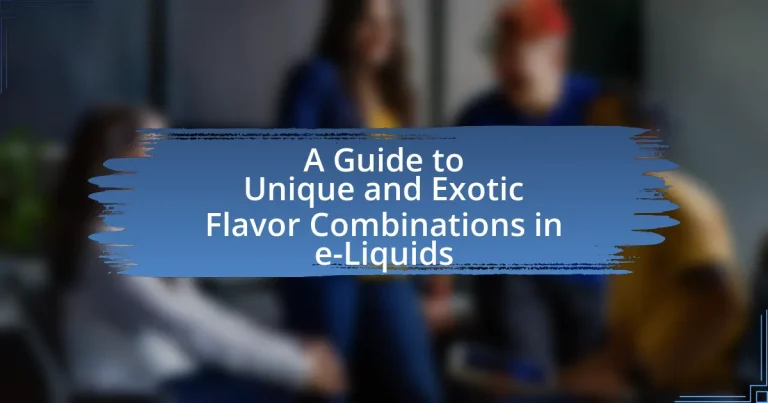The article provides a comprehensive guide to unique and exotic flavor combinations in e-liquids, highlighting blends such as lychee and rose, mango and chili, and coconut and lime. It explores how these combinations enhance the vaping experience by offering diverse sensory profiles and catering to individual preferences. The article also discusses the differences between exotic and traditional flavors, the growing popularity of unique flavors driven by consumer demand, and the key components of flavor profiles in e-liquids. Additionally, it covers techniques for creating and balancing flavors, the role of natural and artificial flavorings, and tips for safe experimentation with e-liquid flavors.

What are Unique and Exotic Flavor Combinations in e-Liquids?
Unique and exotic flavor combinations in e-liquids include blends such as lychee and rose, mango and chili, or coconut and lime. These combinations are crafted to provide a distinctive vaping experience that stands out from traditional flavors. For instance, the pairing of lychee and rose offers a floral sweetness that is both refreshing and aromatic, while mango and chili introduces a spicy kick that enhances the tropical fruit’s sweetness. Coconut and lime create a creamy yet zesty profile, appealing to those who enjoy a balance of flavors. These unique blends are often developed by flavor artisans who experiment with various ingredients to create innovative profiles that cater to diverse palates.
How do these flavor combinations enhance the vaping experience?
Flavor combinations enhance the vaping experience by providing a diverse range of sensory profiles that cater to individual preferences. These combinations can create complex layers of taste, making each puff more enjoyable and satisfying. For instance, pairing fruity flavors with creamy undertones can evoke a dessert-like experience, while mixing menthol with citrus can deliver a refreshing sensation. Research indicates that varied flavor profiles can increase user satisfaction and prolong vaping sessions, as consumers are more likely to enjoy and explore different combinations.
What sensory experiences do unique flavors provide?
Unique flavors provide a rich array of sensory experiences, primarily engaging taste, smell, and even touch. The combination of these senses creates a multi-dimensional experience that can evoke emotions and memories. For instance, the flavor of ripe mango can stimulate taste buds with its sweetness while the aroma enhances the overall experience, making it more vivid. Research indicates that flavor perception is significantly influenced by olfactory cues, as demonstrated in studies showing that 80% of what we taste is derived from our sense of smell. This interplay between taste and smell is crucial in e-liquids, where unique flavor combinations can lead to complex sensory profiles that enhance user enjoyment.
How do exotic flavors differ from traditional ones?
Exotic flavors differ from traditional ones primarily in their unique ingredients and cultural origins. Traditional flavors often rely on familiar, widely-used ingredients such as vanilla, chocolate, and strawberry, which are commonly found in many cuisines. In contrast, exotic flavors may incorporate rare or less common ingredients, such as dragon fruit, lychee, or spices like saffron and cardamom, which are often tied to specific cultural practices or regions. This distinction is evident in the growing popularity of e-liquids that feature these unconventional flavor profiles, appealing to consumers seeking novel experiences.
Why are unique and exotic flavors gaining popularity?
Unique and exotic flavors are gaining popularity due to consumers’ increasing desire for novel and diverse sensory experiences. This trend is driven by a growing interest in global cuisines and the exploration of unique ingredients, which enhances the appeal of products like e-liquids. According to a report by Grand View Research, the global e-liquid market is projected to reach $27.3 billion by 2027, indicating a significant consumer shift towards innovative flavor profiles. Additionally, social media platforms amplify this trend by showcasing unique flavor combinations, further influencing consumer preferences and driving demand for distinctive options in the market.
What trends are driving the demand for these flavors?
The demand for unique and exotic flavors in e-liquids is driven by consumer preferences for personalization and novel experiences. As vaping culture evolves, users increasingly seek distinctive flavor profiles that differentiate their products from traditional tobacco and menthol options. Market research indicates that 60% of vapers prefer fruit and dessert flavors, reflecting a trend towards sweeter, more complex combinations that enhance the vaping experience. Additionally, the rise of social media influences consumer choices, as users share their flavor experiences and recommendations, further fueling interest in innovative flavor combinations.
How do consumer preferences influence flavor development?
Consumer preferences significantly influence flavor development by guiding manufacturers in creating products that align with market demands. For instance, surveys and sales data reveal that consumers increasingly favor unique and exotic flavors, prompting e-liquid producers to experiment with combinations like tropical fruits or dessert-inspired profiles. Research conducted by Mintel in 2021 indicated that 60% of consumers are interested in trying new flavors, which drives innovation in flavor formulation. This consumer-driven approach ensures that flavor development remains relevant and appealing, ultimately shaping the offerings in the e-liquid market.

What are the Key Components of Flavor Profiles in e-Liquids?
The key components of flavor profiles in e-liquids include primary flavors, secondary flavors, and additives. Primary flavors are the dominant taste notes, such as fruit, dessert, or menthol, which define the overall profile. Secondary flavors complement the primary notes, adding depth and complexity, such as spices or creaminess. Additives, like sweeteners or cooling agents, enhance the vaping experience by modifying the mouthfeel or sweetness. These components work together to create a balanced and enjoyable flavor experience, as evidenced by consumer preferences for specific combinations that enhance satisfaction and enjoyment in vaping.
How are flavor notes categorized in e-liquids?
Flavor notes in e-liquids are categorized primarily into four main groups: fruit, dessert, menthol, and tobacco. Each category encompasses a variety of specific flavors that appeal to different preferences. For instance, fruit flavors can include options like strawberry, mango, and apple, while dessert flavors might feature vanilla custard or chocolate cake. Menthol flavors provide a cooling sensation, often combined with other flavors for added complexity, and tobacco flavors aim to replicate the taste of traditional cigarettes or cigars. This categorization helps consumers easily identify and select e-liquids that match their taste profiles.
What are the primary flavor categories?
The primary flavor categories are sweet, sour, salty, bitter, and umami. These categories encompass the basic tastes that humans can perceive, forming the foundation for more complex flavor profiles. Sweet flavors are typically associated with sugars and certain fruits, sour flavors come from acids like citric acid, salty flavors arise from sodium chloride, bitter flavors are often linked to compounds like caffeine, and umami is recognized as a savory taste, primarily from amino acids such as glutamate. These categories are essential in understanding flavor combinations, particularly in the context of e-liquids, where they can be blended to create unique and exotic experiences.
How do base notes, middle notes, and top notes interact?
Base notes, middle notes, and top notes interact in a layered structure that defines the overall scent profile of a fragrance or e-liquid. Top notes are the initial scents perceived upon application, providing a fresh and immediate impression, while middle notes emerge as the top notes dissipate, forming the heart of the fragrance and contributing to its character. Base notes, which are the heaviest and longest-lasting, provide depth and richness, anchoring the lighter notes and ensuring a balanced experience. This interaction creates a dynamic olfactory journey, where each layer complements and enhances the others, resulting in a harmonious blend that evolves over time.
What role do natural and artificial flavorings play?
Natural and artificial flavorings enhance the taste and aroma of e-liquids, making them more appealing to consumers. Natural flavorings are derived from real food sources, providing authentic flavors, while artificial flavorings are chemically synthesized to mimic these tastes, often allowing for a wider variety of flavors at a lower cost. The use of both types of flavorings enables manufacturers to create unique and exotic flavor combinations that cater to diverse consumer preferences, thereby expanding the market for e-liquids.
How do natural flavorings differ from artificial ones?
Natural flavorings are derived from real food sources, while artificial flavorings are synthesized chemically to mimic those flavors. Natural flavorings contain compounds extracted from fruits, vegetables, herbs, or spices, ensuring they retain the original taste profile, whereas artificial flavorings often use synthetic chemicals that may not replicate the complexity of natural flavors. For instance, the flavor compound vanillin can be sourced from vanilla beans (natural) or produced synthetically (artificial), with the latter lacking the nuanced taste of the former. This distinction impacts not only flavor authenticity but also consumer perception, as many prefer natural ingredients for their perceived health benefits and safety.
What are the benefits and drawbacks of each type?
The benefits of unique and exotic flavor combinations in e-liquids include enhanced sensory experiences and increased consumer interest, leading to higher sales. For instance, flavors like mango chili or lavender mint can attract adventurous vapers seeking novel tastes. However, the drawbacks include potential market saturation and the risk of alienating traditional users who prefer classic flavors. Additionally, some exotic combinations may not appeal to a broad audience, limiting their commercial viability.

How Can You Create Your Own Unique Flavor Combinations?
To create your own unique flavor combinations, start by understanding the basic flavor profiles: sweet, sour, salty, bitter, and umami. By blending these profiles, you can experiment with different ingredients to discover new tastes. For instance, combining fruity flavors like mango with a creamy base can yield a tropical dessert flavor, while mixing herbal notes like mint with citrus can create a refreshing experience. Research shows that flavor pairing often relies on complementary ingredients, as seen in culinary practices where certain flavors enhance each other, such as chocolate and chili. This method can be applied to e-liquids, allowing for innovative and personalized flavor experiences.
What ingredients are essential for crafting e-liquid flavors?
The essential ingredients for crafting e-liquid flavors are propylene glycol, vegetable glycerin, flavoring concentrates, and nicotine (optional). Propylene glycol and vegetable glycerin serve as the base liquids, providing the necessary viscosity and vapor production. Flavoring concentrates, which can be natural or artificial, impart the desired taste profiles, while nicotine is included for those who prefer it. These components are fundamental in creating a balanced and enjoyable vaping experience, as they directly influence the flavor intensity and overall quality of the e-liquid.
What are the best flavoring concentrates to use?
The best flavoring concentrates to use include natural extracts like vanilla, fruit flavors such as strawberry and mango, and dessert flavors like custard and chocolate. These concentrates are popular due to their versatility and ability to create unique and exotic flavor combinations in e-liquids. For instance, vanilla extract is widely used for its rich and creamy profile, while fruit flavors provide a refreshing and vibrant taste. Additionally, dessert flavors like custard have gained popularity for their smooth and indulgent characteristics, making them ideal for creating complex blends.
How do you balance flavors for a harmonious blend?
To balance flavors for a harmonious blend, one must identify the primary flavor profiles and adjust their intensity to achieve equilibrium. This involves using complementary flavors that enhance each other while avoiding overpowering any single note. For example, in e-liquids, combining sweet and tart flavors can create a balanced experience, as seen in popular combinations like strawberry and lemon. The key is to taste and adjust incrementally, ensuring that no flavor dominates the blend, which is supported by the principle of flavor synergy in culinary science.
What techniques can enhance flavor mixing?
Techniques that can enhance flavor mixing include proper steeping, using complementary flavor profiles, and employing layering methods. Steeping allows flavors to meld and develop over time, improving overall harmony; for instance, steeping e-liquids for a week can significantly enhance the depth of flavor. Complementary flavor profiles, such as pairing sweet and tart notes, create balance and complexity, making the final product more enjoyable. Layering methods involve adding flavors in stages, allowing each to shine while contributing to the overall mix; this technique is often used in culinary applications and can be effectively applied to e-liquid formulation.
How does steeping affect flavor development?
Steeping enhances flavor development by allowing the ingredients in e-liquids to meld and mature over time. This process facilitates the extraction of flavors from various components, leading to a more balanced and complex taste profile. Research indicates that steeping can improve the overall smoothness and richness of flavors, as chemical reactions occur that alter the compounds present in the mixture. For example, a study published in the Journal of Food Science found that aging certain flavor compounds can lead to the formation of new aromatic compounds, which significantly enhance the sensory experience of the final product.
What tools can assist in flavor experimentation?
Tools that can assist in flavor experimentation include flavoring concentrates, digital scales, and mixing software. Flavoring concentrates provide a wide range of taste profiles, allowing for diverse combinations. Digital scales ensure precise measurements of ingredients, which is crucial for consistency in flavor development. Mixing software helps in formulating recipes and tracking variations, making it easier to replicate successful blends. These tools collectively enhance the process of creating unique and exotic flavor combinations in e-liquids.
What are some popular unique and exotic flavor combinations?
Some popular unique and exotic flavor combinations include mango and chili, lavender and lemon, and coconut and lime. These combinations are favored for their ability to create a balance of sweetness, heat, and acidity, enhancing the overall sensory experience. For instance, the pairing of mango and chili offers a sweet and spicy profile that is commonly found in various cuisines, while lavender and lemon provide a floral and citrusy contrast that is refreshing. Coconut and lime create a tropical flavor that is often used in beverages and desserts, appealing to those seeking a vibrant taste.
Which combinations are trending in the vaping community?
Tropical fruit blends, particularly combinations like mango-pineapple and watermelon-strawberry, are trending in the vaping community. These flavor profiles are popular due to their refreshing taste and appeal during warmer months. Additionally, dessert flavors such as vanilla custard paired with caramel or chocolate are gaining traction, as they provide a rich and satisfying vaping experience. According to industry reports, these combinations have seen increased sales and positive reviews, indicating a strong preference among vapers for these unique and exotic e-liquid flavors.
How do cultural influences shape flavor choices?
Cultural influences shape flavor choices by determining the ingredients, preparation methods, and taste preferences prevalent in different societies. For instance, Asian cuisines often emphasize umami flavors through ingredients like soy sauce and miso, while Mediterranean diets frequently highlight herbs and olive oil, reflecting regional agricultural practices and historical trade routes. Studies show that cultural background significantly affects individual taste perception and preferences, as evidenced by research published in the journal “Appetite,” which found that people from different cultures have varying thresholds for sweetness and saltiness based on their culinary traditions.
What tips can help you enjoy unique and exotic flavors safely?
To enjoy unique and exotic flavors safely, start by researching the ingredients and sourcing them from reputable suppliers. This ensures that the flavors are safe for consumption and free from harmful additives. Additionally, consider starting with small quantities to gauge your body’s reaction to new flavors, as some individuals may have allergies or sensitivities to certain ingredients. It is also advisable to check for any relevant safety certifications or lab testing results associated with the e-liquids, as this can provide assurance of quality and safety. Following these tips can help mitigate risks while exploring diverse flavor profiles.
How can you ensure quality and safety in your e-liquids?
To ensure quality and safety in e-liquids, manufacturers should implement rigorous testing protocols and adhere to industry standards. This includes sourcing high-quality ingredients, conducting laboratory tests for purity and consistency, and following Good Manufacturing Practices (GMP). For instance, the American E-Liquid Manufacturing Standards Association (AEMSA) provides guidelines that emphasize the importance of ingredient traceability and contamination prevention. Additionally, third-party testing can verify the absence of harmful substances, ensuring that the final product is safe for consumers.
What are common mistakes to avoid when experimenting with flavors?
Common mistakes to avoid when experimenting with flavors include using too many flavors at once, which can lead to a muddled taste, and not allowing adequate steeping time for the flavors to blend properly. Additionally, failing to keep a flavor log can result in forgetting successful combinations or ratios. Overlooking the importance of balancing sweet, sour, and savory notes can also hinder the overall flavor profile. Lastly, neglecting to test flavors in small batches can lead to wasted materials if the combination does not work.

